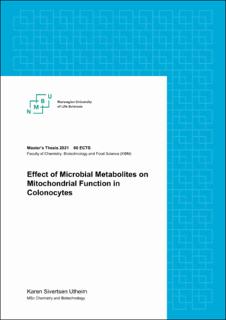| dc.contributor.advisor | Rudi, Knut | |
| dc.contributor.advisor | Eide, Lars | |
| dc.contributor.author | Utheim, Karen Sivertsen | |
| dc.date.accessioned | 2021-04-27T18:25:05Z | |
| dc.date.available | 2021-04-27T18:25:05Z | |
| dc.date.issued | 2020 | |
| dc.identifier.uri | https://hdl.handle.net/11250/2739989 | |
| dc.description.abstract | The colonocytes are the most abundant cell type in the colonic epithelium and function both as a barrier and a mediator between the human body and the components in the gut lumen, such as the microbiota and its metabolites. In particular, the gut microbiota produces the short chain fatty acids (SCFA): acetate, propionate and butyrate, with butyrate being the colonocytes preferred energy source. Branched chain fatty acids (BCFA) are major constituents of vernix caseosa and human milk, and are therefore consumed by the fetus and the infant. The aim of this study was to investigate the effects these two groups of fatty acids have on colonocytes.
Caco-2 cells were used as a colonocyte model and the cells were treated with either 4 mM SCFA or 40 μM BCFA. RNA-sequencing was used to identify genes and pathways influenced by the fatty acids. Butyrate showed most effect on the gene expression, and the associated pathways were related to regulation of the cell cycle. Propionate was the second most influential treatment on the gene expression and shared some of the effects observed with butyrate. The mitochondrial activity of the cells was assessed by measuring gene expression and respiration. Both SCFA and BCFA had impact on mitochondrial activity, but the effects differed between the groups. The results from butyrate-treated cells indicated a shift from glycolysis to β-oxidation, while 15-methylhexadecanoic acid seemed to increase the cells respiratory capacity. The concentration of BCFA was measured in the fecal samples from 176 infants at 12 months of age in the PreventADALL cohort. The most abundant fatty acid measured was 12-methyltetradecanoic acid, and 14-methylhexadecanoic acid was the least abundant.
In conclusion, the results of this study suggest that butyrate is the fatty acid that have most impact on the cells but also that propionate may play an important role in the infant gut, particularly when butyrate concentrations are low. The observed effects of the BCFAs also demonstrate that these fatty acids should be considered when deciphering the infant development. However, the study was limited to investigating fatty acids individually and at a single concentration. Further work is therefore needed to elucidate the biologic function of the fatty acids in the infant gut. | en_US |
| dc.description.abstract | Kolonocyttene er den mest utbredte celletypen i epitelet i tykktarmen og fungerer både som en barriere og et bindeledd mellom kroppen og innholdet i tarmen, som mikrobiotaen og metabolittene den produserer. Mikrobiotaen produserer spesielt de kortkjedede fettsyrene eddiksyre, propionsyre og smørsyre, hvorav smørsyre er den foretrukne energikilden til kolonocyttene. Forgrenede fettsyrer utgjør en stor andel av vernix caseosa og morsmelk, og konsumeres derfor av både foster og spedbarn. Formålet med denne studien var å undersøke effekten kortkjedede og forgrenede fettsyrer har på kolonocyttene.
Caco-2-celler ble brukt som en modell for kolonocytter og ble behandlet med 4 mM SCFA eller 40 μM BCFA. RNA-sekvensering ble brukt til å identifisere gener og reaksjonsveier som påvirkes av fettsyrene. Smørsyre førte til mest effekt på genuttrykket, og reaksjonsveiene som ble identifisert var involvert i reguleringen av cellesyklus. Propionsyre var den behandlingen med nest mest påvirkningskraft, og den hadde noen av de samme effektene som ble observert med smørsyre. Den mitokondrielle aktiviteten i cellene ble vurdert ved å måle genuttrykk og respirasjon. Både kortkjedede og forgrenede fettsyrer påvirket den mitokondrielle aktiviteten, men med ulikt utfall. Cellene som ble behandlet med smørsyre ga resultater som indikerte en overgang fra glykolyse til β-oksidasjon, mens 15-metylheksadekansyre viste tegn til å øke cellenes respirasjons-kapasitet. Konsentrasjonen av forgrenede fettsyrer ble malt i avføringsprøver fra 176 spedbarn på 12 måneder i PreventADALL-kohorten. Fettsyren med høyest median-konsentrasjon var 12-metyltetradekansyre, og 14-metylheksadekansyre hadde lavest median-konsentrasjon.
Oppsummert, viser resultatene fra denne studien at smørsyre er den fettsyren som har størst påvirkning på cellene, men at propionsyre også kan spille en viktig rolle i tarmen hos spedbarn, spesielt når konsentrasjonen av smørsyre er lav. Effektene av de forgrenede fettsyrene understreker også at disse bør inkluderes i utredningen av spedbarns utvikling. Begrensninger ved studien var at fettsyrene kun ble undersøkt enkeltvis og bare ved en konsentrasjon. Videre arbeid er derfor nødvendig for å beskrive funksjonen disse fettsyrene har i tarmen hos spedbarn. | en_US |
| dc.language.iso | eng | en_US |
| dc.publisher | Norwegian University of Life Sciences, Ås | en_US |
| dc.rights | Attribution-NonCommercial-NoDerivatives 4.0 Internasjonal | * |
| dc.rights.uri | http://creativecommons.org/licenses/by-nc-nd/4.0/deed.no | * |
| dc.title | Effect of microbial metabolites on mitochondrial function in colonocytes | en_US |
| dc.type | Master thesis | en_US |
| dc.description.localcode | M-KB | en_US |

